As their ‘big day’ approaches, residents of the Region Two (Pomeroon/Supenaam) Amerindian community of Capoey are fine tuning preparations for their annual Heritage celebrations.

Tucked neatly away from the Essequibo Coast Public Road passing through the villages of Affiance and Taymouth Manor, is the small, breezy community which is situated near to Capoey Lake.
On a recent visit to the area, Stabroek News interacted with residents in the sprawling lakeside community, where some were praying for rain to keep the water level in the lake at a sufficient level to allow the visitors who are expected this weekend to access the village.
Secretary of the Capoey village council Mayleen Edwards told this newspaper that the community was founded several decades ago when several families of Amerindian descent, mainly from the Arawak tribe, settled there. She said Capoey is a quiet community with most residents involved in farming and the timber trade. Edwards explained that while some persons saw and dress lumber at Capoey, in tandem with the required regulations governing the economic activity, some persons, mainly the males, leave the community to work with timber companies within Guyana’s interior.
Toshao of Capoey Valerie DeYoung told Stabroek News that the farmers in the area encountered the dreaded acoushi ant, which had been destroying crops. She said she had made representation to the relevant authorities to furnish a fogging machine, which she noted, will be of great benefit to the community’s farmers.
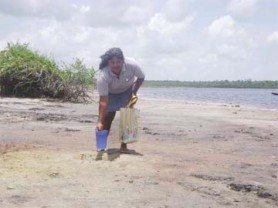
As Edwards chatted with Stabroek News, her female friends were busy preparing the popular piwari beverage, as an empty 100-gallon container stood under the thatched roof hut, waiting to be filled with the potent beverage. The women explained that the container would be filled with piwari for the ‘village day’, and some said they could not wait for that day to come. They said that a number of persons from the villages along the Essequibo coast venture into the community “to have a good time”. Some said that Capoey has the potential to become a tourist destination if it is marketed more frequently to the travelling public. They said that in addition to its location, Capoey has a number of interesting historical places and features to offer to visitors. These include the five Christian churches within the community as well as the small beach-side locations along parts of the nearby lake. Along the beaches, several residents could be seen dipping water from several springs (small ponds) along the sides of the lake, used mainly for drinking and cooking purposes.
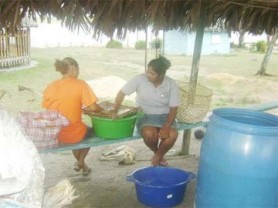
‘Uncle Steven’
As Stabroek News travelled further north of the community, accompanied by two guides from the village, several persons could be seen going about their everyday chores. One such person is Steven Henry, 75, the second oldest resident at Capoey and a former resident of Barabina Hill in the North West District, who moved to the community in his teenage years. According to ‘Uncle Steven,’ as he is referred to by residents, Capoey is a “peaceful and quiet place”. He said that persons from busy coastland areas such as Georgetown should visit the community to relax.
As he recounted his life at Capoey, Henry said that he relocated from Region One at age 15, and settled at Canal Number Two polder in 1953 with another sibling. He said at the time India had celebrated independence as he could recall that Guyanese of Indian descent, who were in the vehicle he was travelling on along the West Coast Demerara, one day that year, were in a celebratory mood. He said following the death of his sister, with
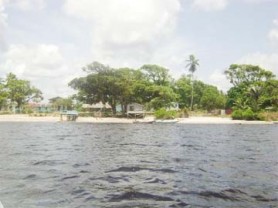
whom he lived with at Canal Number Two, he relocated to Capoey with her husband, whom he referred to as an adopted father. He said the man was at the time venturing into the timber industry. Henry said he quickly settled at Capoey, as he recounted several families, including the Edwardses, Francises and Gordons whom he met on his arrival at the village. And with a smile on his face, Henry said that he soon, “spotted a companion”, Ursula; the two have been together from 1960 to today and have eight children.
Henry said he sought employment out of the community in his youth, like any young man. He recalled working at Wineperu in Region Ten with a timber company known as British Guyana Timbers Limited. Henry said he worked hard and was employed in the roads division of the company. He said he worked with several other timber companies before retiring several years ago after contracting tuberculosis (TB). According to the jovial senior citizen, in its initial years, Capoey was a very isolated community but soon after a mixture of persons settled along the sides of the nearby lake.
He recalled that when he settled at Capoey, there was only the Methodist Church and the primary school in the village along with a few scattered houses.
Splendid view
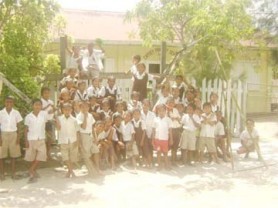
Today there are approximately 385 people living at Capoey, the community being accessible by road and boat, in that order, as one has to travel along a two-mile long road which branches off from the Essequibo Public Road close to the village of Taymouth Manor followed by boat across the Capoey Lake.
The splendid view which greets any visitor on arrival at the lake, graduates into a spectacle as one crosses the lake with the village of Capoey in sight. The community is home to several denominations of Christianity, mainly, Full Gospel, Seventh Day Adventist, Pentecostal and Methodist.
The community is governed by a seven-member village council with the Toshao at its helm, that person being constitutionally elected every two years. The community has a nursery and primary school, village office, library, an all-purpose hall as well as a number of benabs and a playground, all centrally located at the front of the village close to the lakeside. Scenic views abound.
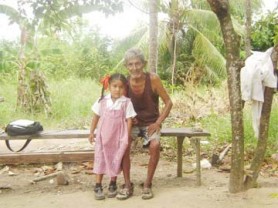
Residents told Stabroek News that the travelling public should join the community when it celebrates its Heritage Day activities on Sunday, September, 27, which will include cultural presentations, since according to them, any visit to the village will leave a lasting impression on one’s mind.










